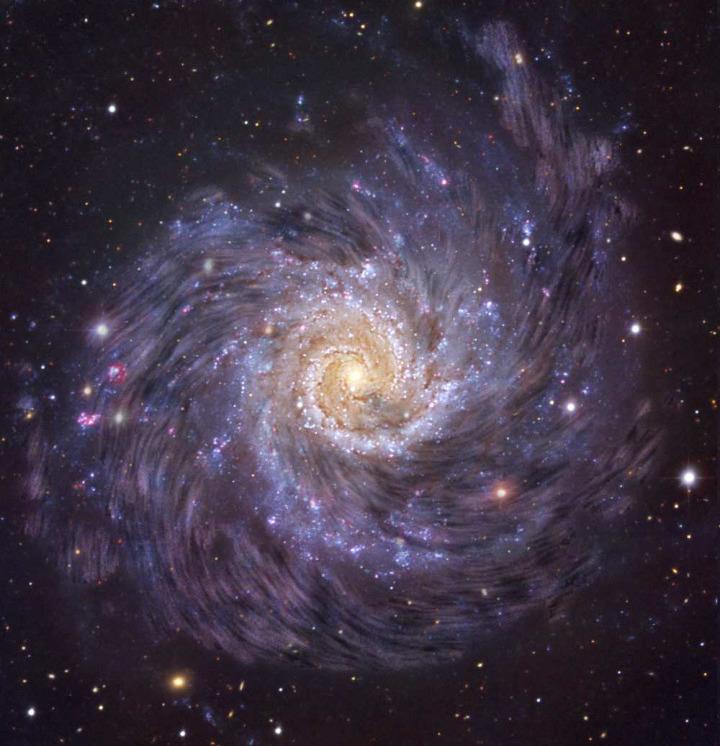Understanding cosmic magnetism
At a glance
- Radio astronomy is uniquely suited to studying cosmic magnetism through processes observed only in the radio regime
- The SKAO era will transform our understanding of how magnetism has shaped the Universe
- Astronomers will create a 3D map of the vast magnetic "cosmic web", which connects the Universe on the grandest scales
- With unmatched sensitivity, the SKA telescopes will observe thousands of distant, faint galaxies, building a detailed picture of the magnetic environment

Magnetism is apparent to us at very small scales on Earth, but it also pervades the entire Universe, with interstellar gas, planets, stars and galaxies all showing the presence of magnetic fields. Despite their importance, the origin of magnetic fields is still not known.
Did significant primordial fields exist before the first stars and galaxies? If not, when and how were magnetic fields subsequently generated? What maintains the present-day magnetic fields of galaxies, stars and planets?
The SKA telescopes will bring us closer to answering these and many other questions, allowing astronomers to map the vast magnetic structure which connects the Universe on the grandest scales, known as the cosmic web. The aim? Revealing how magnetic fields originated and how they shaped the Universe we see today.
The newest generation of radio telescopes, in particular SKA pathfinders and precursors like LOFAR, MWA, ASKAP, and MeerKAT, are especially well-suited to studying cosmic magnetism thanks to the broad range of radio frequencies they cover and high sensitivity, two key things required to study faint and distant objects. The SKA telescopes will provide another huge leap in capabilities, enabling magnetism studies which are more detailed than ever before.
Strength and weakness
Magnetic fields are generated whenever a charged particle like an electron or a proton moves, and the Universe is full of moving charged particles. The fields' strength varies immensely compared to those we encounter on Earth, from trillions of times stronger around the cores of dead stars (neutron stars or pulsars), to the vast regions between galaxies where magnetic fields may be a billion times weaker than on Earth. Studying all these different environments is vital to track how magnetism has evolved in the Universe.
The challenge in studying cosmic magnetism is that, while stars and galaxies can be seen directly by the light they emit, magnetic fields are invisible even to the largest optical telescopes. How will the SKA telescopes detect something that cannot be seen? Through three physical mechanisms which are observable at radio wavelengths.
- Faraday rotation
Radio telescopes are highly sensitive to polarised radiation – radio waves emitted by a distant object which travel to us along a single plane, rather than in lots of different directions. On their way to Earth, radio waves can be “twisted” by the magnetic fields of other objects they encounter, something radio astronomers can detect and use to measure the magnetic environment of those objects in between.
- Zeeman splitting
Narrow emission lines produced by atoms and molecules are split by the effects of magnetic fields. Emission lines are like the fingerprints of astronomical objects. When these lines split, it signals a change in energy that astronomers can observe, and enables them to measure the strength of the magnetic fields.
- Synchrotron emission
This type of radiation is generated by charged particles spiralling around magnetic field lines at close to the speed of light, which radio telescopes can detect. If we see a celestial body emitting synchrotron emission, we know that this object must be magnetic, and we can use its properties to determine the strength of its magnetic field.
As the SKA telescopes will be so much more sensitive than current telescopes, they will be able to look at any part of the sky and detect the radio emission from thousands of distant faint galaxies, enabling astronomers to build up a detailed picture of the magnetic environment.
The mechanisms of Faraday rotation, Zeeman splitting and synchrotron emission will allow us to identify the shape and strength of the magnetic field in our Milky Way, and how it compares to the magnetism in other galaxies, as well as establishing magnetism's role on the formation of individual stars and galaxies, and where and how cosmic magnetic fields originated.




